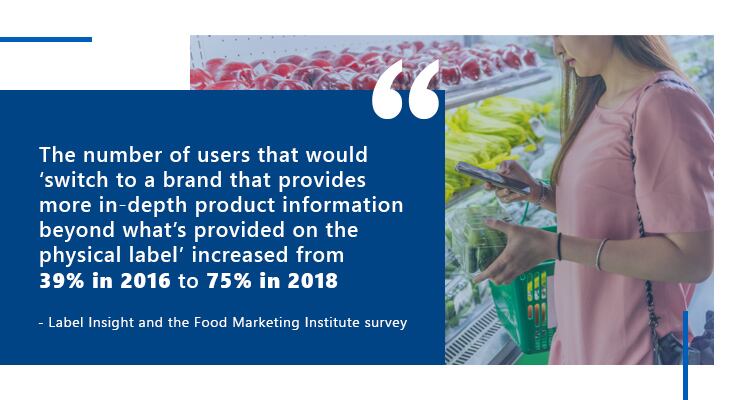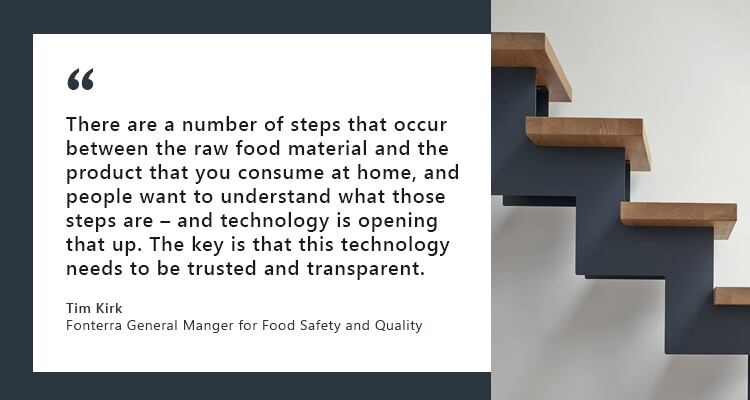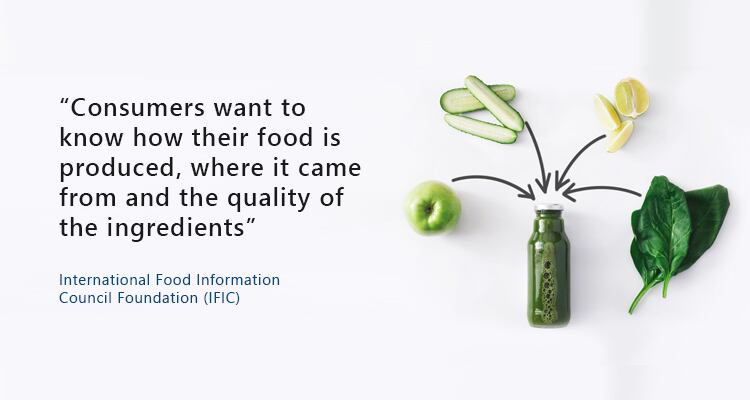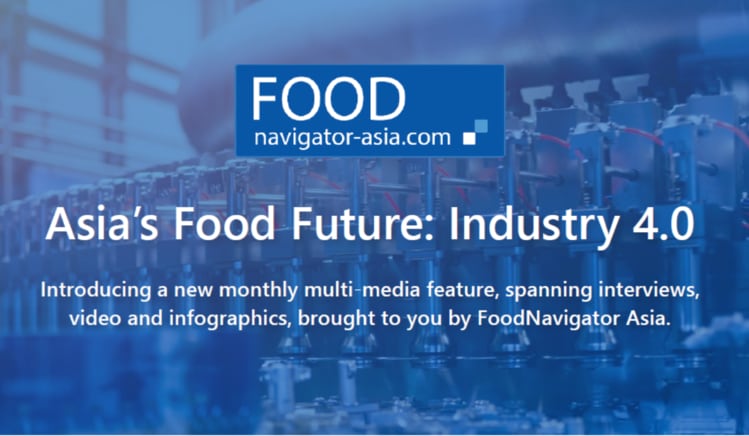According to data from the Label Insight and Food Marketing Institute survey, the number of users willing to switch to brands that provide ‘more in-depth information beyond what’s provided on the physical label’ rose almost twofold from 2016 to 2018, from 36% to 78%.
In terms of value, Allied Market Research has predicted that the global food traceability market will reach some US$22.3bn in 2025, growing 9.3% from US$11mn in 2017.
Along with a rise in consumer awareness, mere information about where a product is from is no longer sufficient: F&B manufacturers would also need to pay attention to the quality of information such as processing methods, transport logistics, ingredient quality and certifications.
One of the most commonly-known traceability solutions in the market is blockchain, which is valued for its incorruptibility and security benefits.
“[In the food and beverage industry], communicating information to customers is key, and blockchain [enables] this in a transparent, secure and efficient way [with] a granular level of accuracy,” F&B blockchain solution provider Alex Vitale told us.
However, blockchain technology is still the relative new kid on the block, and therefore carries some teething issues such as scalability and cost, which has led some F&B manufacturers to develop their own in-house solutions.
An example of this is New Zealand dairy giant Fonterra, which has developed a global electronic traceability system which currently tracks all its products worldwide.

“The global traceability system we have deployed allows us to track the product all the way from the farm until it reaches customers,” Fonterra General Manager for Food Safety and Quality Tim Kirk told FoodNavigator-Asia.
“The system has two main components, which we refer to as an internal trace system and external trace system.
“The internal trace system is the backbone of the entire technology, and is where all of the [traceability] power sits, [whereas] the external trace system is designed to empower our customers to access the authenticity, provenance and origin of product at the point-of-purchase.”
Fonterra claims to be the world’s first dairy company to provide this end-to-end internal traceability system that has also provided consumers access into this system.
“We decided to use a QR code to provide access, because based on our [research] prior to deploying this solution, we found this to be the most practical and accessible solution for consumers [that can provide] real-time information,” added Kirk.
“Consumers also get access to the batch code – this is a key piece of information that we’ve never given consumers previously. This allows them to access the [internal system], and is the key linkage between the two.”

Within the Asia Pacific region, Fonterra has deployed this internal traceability system in each of the countries it operates in, including Australia, New Zealand, China, Hong Kong, South East Asia, India, and Sri Lanka. Globally, all its products are tracked within the system.
“All Fonterra products are included within the global traceability system, and [this is in line] with our commitment to have electronic traceability on all of our products by 2020.”
“This traceability technology gave us the ability to open up [to consumers] on the origin of their products in a [transparent manner] at a global scale.”
Watch the video below to find out more:
Allaying safety and fraud concerns
Food safety concerns are a major driver in the growth of food traceability solutions worldwide, with many traceability solution providers angling their solutions around this.
Mintel reports have revealed that 69% of consumers are hesitant to purchase an item they do not trust and 53% are concerned about the safety of products bought online.
“Five years ago, if there was a product recall, most people would manually take their products off the shelves, it was cheaper, and they didn’t see the need to invest in a traceability solution,” Rockwell Automation Asia Pacific Marketing Director John Watts told FoodNavigator-Asia.
“A lot has changed now. The impact of a bad product on [an F&B brand] brand is so much more instant and broad-based now.”

Rockwell’s consumer packaged goods (CPG) suite is an example of a traceability platform that traces products through the production life cycle, ‘from raw material into the plant, to finished goods out, and every stage in between’.
“An example of [how this could be applied to food safety] would be to trace concerns with regulatory issues that might have been breached, such as food contamination,” said Watts.
Rising fears over food fraud is another driving factor, for example within the tea industry where 25% to 50% of black teas are adulterated using substitutes such as lower-grade teas, used teas, or even fillers like wood, chips and sugar.
Singaporean firm teapasar has developed a traceability solution specifically targeting this area, in the form of a commercial portable device termed ProfilePrint that can quickly and efficiently track and authenticate a tea or dried food sample.
The technology was first developed by teapasar in collaboration with the National University of Singapore’s (NUS) Food Science and Technology Programme and the Agency for Science, Technology and Research’s (A*STAR) BioTransformation Innovation Platform (BioTrans).
“ProfilePrint [makes] it possible and convenient for all stakeholders in the dried food and tea industry to authenticate food products at any point in the supply chain and retrieve results real time in a cost-effective manner,” teapasar Executive Director Alan Lai told us.
“ProfilePrint solution was developed to focus on dried plant-based food product category due to the increasing rate of adulteration and fraud uncovered of tea, chinese herbs, spices and food ingredients such as rice in recent years.”

Analysis requires a mere 3g to 5g sample of the product, with no pre-processing such as powderising or solvents required.
“Within seconds, without destroying the samples, the scanner captures the molecular fingerprint data, converts this raw data into ProfilePrint based on our proprietary algorithm developed based on combination of chemometrics and AI,” explained Lai.
“It is [then] matched real-time against our cloud-based database to identify quality, adulteration, geographic origins and the taste profile of the food product.”
ProfilePrint can differentiate between different regions (e.g. Taiwan oolong versus Vietnam oolong); terroir (high land versus low land), harvest date (spring versus autumn), and even if a product has been adulterated.
“This technology can best benefit B2B stakeholders in the food ingredient supply chain, such as the local processor, exporter, wholesaler as well as the end-product manufacturer,” said Lai.
“[These industry players] process huge volumes of raw ingredients, and base authenticity, quality and taste-profiling on human tasting and visual checks.”
At present, the device is priced at a ‘few thousand dollars per device and will be a SaaS subscription model based on usage’. It also only analyses plant-based food products although there are plans to include other categories such as non-plant, non-food or liquid.
Traceability challenges in F&B
Despite the obvious importance and growth of traceability in F&B, there still exist various challenges to adoption, especially in the Asia Pacific region.
According to Rockwell Asia Pacific Connected Services CoE manager Sandip Choudhari , there are three perceived barriers in this area that lead to hesitancy for F&B companies.
“[These include] sufficient skill levels among their workers that may prevent them from adapting quickly, high upfront investment costs and cybersecurity risks,” he said.
Watts added that: “Certain industries like automotive move a lot faster because they are compelled to due to market forces. It’s a case of: if you don’t adapt, you don’t survive.”
That said, he emphasised that the importance of traceability technology for the future of F&B is undeniable, especially in terms of tracking products through the supply chain and ‘enforcing quality’.




